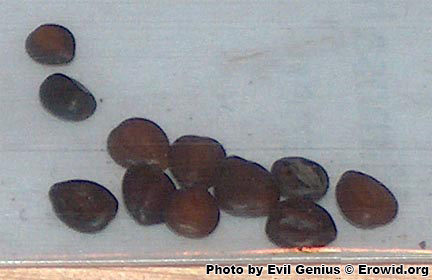Ayahuasca: alkaloids, plants & analogs
Section 3 : Part 2 :
Mimosa Cultivation

Mimosa hostilis seeds.
Mimosa hostilis seeds germinated within a week to 10 days; using seeds scarified with a file and soaked for a short time. Good germination; over 50%, all within a few days of each other. (Seeds from JLF [and again later, at even higher germination rates, using seeds from River's Source]) [Second and third year plantings showed absolutely no germination.] Gnostic Gardens recommends soaking Mimosa seeds in 60°r;C (140°r;F) water for 20 minutes before planting.
One plant which had a branch exposed to passing foot traffic and was gently moved by passers-by grew far faster and larger; producing more branches than identical plants that were better protected. They did best when direct sun was part day or at least filtered for the better part of the day. Good growth required a few hours of daily sun exposure.
Water moderately. Heavy only during hot weather. Clay seemed to allow better growth than plastic.
Best results came when using a mineral-rich, well drained soil, similar to cactus soil but with slightly more organics. A couple heaping tablespoons each of powdered gypsum/ dolomite & a bone meal/ bloodmeal blend were added per 5 gallons of the soil. (Soil composed of 40% granite sand & 50% Jungle Growth professional grower's mix, with 10% additional perlite. All % by volume NOT weight)
Sensitive to freezing. A minimum temperatures of 40°r;F (4°r;C) is recommended. Most have survived temperatures in the 30s, and even a brief, mild frost, often showing a weak, slow recovery, but, so far, some have always died.
Nearly all dropped their leaves when excessively chilled; showing a slow and feeble recovery in spring. [Unlike many plants, trees need normal watering during such `resting' periods. Growth during the dormancy of trees is focused entirely on the development of the root system.] Those brought in during the cold spells kept most of their leaves through the winter and began growing faster and with more vigor in the spring.
- K. Trout (observations 1995-2003)

